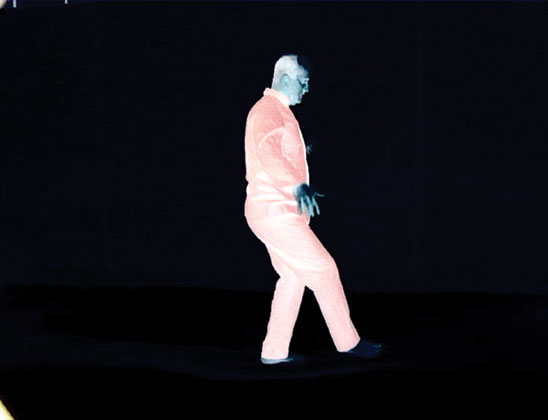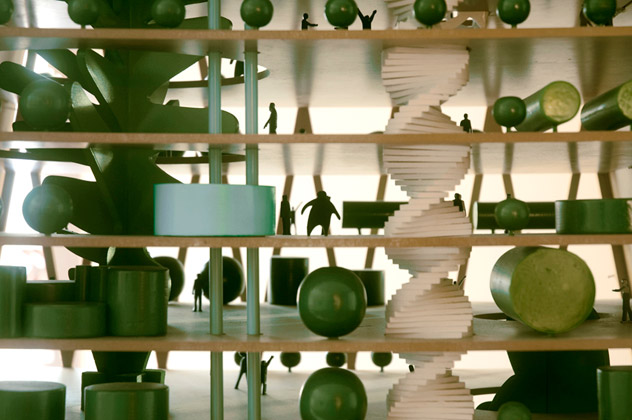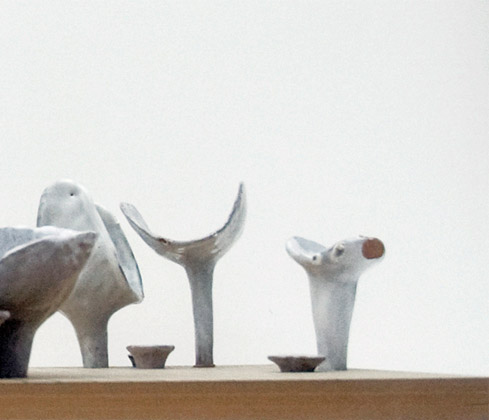| PEDRO REYES |
|
Group Activity, Video 25 min, Wood and Carpet construction, Arnolfini, Bristol UK
In collaboration with The Studio Upstairs
2005
|
|
I was invited to work with a group inspired by R.D Lang's principles of a non-hierarchical environment. Here, individuals with certain psychological problems share a workplace. Labels such as “sane” and “insane” are abolished and replaced by a common status in which everyone is an artist.
Before my arrival, I asked the group to keep diaries of their dreams. Each of them chose a dream with which to work.
We didn't seek interpretation; symbols are entirely personal and only the dreamer can say what they really mean. Waking thoughts, once set into motion, press to be completed in dreams. By turning dreams into short movies, we aimed to create a third realm, or metadream. These metadreams worked in two ways: for some, they were a space not only to stage their dreams, but also to introduce changes to them. Thus, the resulting process was akin to lucid dreaming. Others, as a side effect of their psychiatric medications, had lost the capacity to dream. As a result, these people had to recall dreams that were twenty years old. DREAM DIGESTOR PARTICIPANTS SURVEY 1. Do you record your dreams in some way? How? 2. Do you have music in your dreams? What kind? 3. Do you think that, in your dreams, you can establish contact with somebody who has died? 4. Do you dream in color or black and white? 5. Does the 'you' that other people dream about have any connection to you? 6. Do you ever swim or fly in your dreams? 7. Do medications/drugs influence your dreams? How? 8. Are the people that you dream about known to you, or are they a combination of more than one person? 9. If you dream of a sexual encounter, is it satisfactory? Until what point? 10. Do you have many recurring dreams? 11. Would you like to be able to replay your dreams? 12. How many of your dreams contain or manifest strong feelings? 13. How m any dreams do you not remember? 14. Have any images from advertising ever appeared in your dreams? If so, which? 15. Do you ever dream about dying? If so, did you wake up? Did you keep on dreaming? 16. Have you ever met yourself in your dreams? If so, did you tell yourself anything? 17. What is reality? Whose reality is it? 18. Could you make an appointment to meet someone you know in your dreams? How? 19. Do you tell people that you have dreamt about them? 20. Are you able to go back into your dream after waking? 21. Do you dream about particular parts of your body? Which parts? 22. What sort of animals appear in your dreams? 23. Would you like there to be a place where you could rent other peoples dreams? Would you want your dreams to be included? 24. Have you ever taken control of your dreams (lucid dreaming)? 25. Have you ever confused memory and dream? 26. What would a dream museum be like? When is a dream a nightmare? |
|
Architectural Model, Painting, Printed Material
In collaboration with Parque Humano
2005
|
|
Tlatelolco its an icon of Modernity, a housing complex built for 100,000 inhabitants. It has been the setting for many significant moments of Mexico City history: The signing of the Tlatelolco treatise, the students’ protests in 1968 and the earthquake of 1985. The primary building of this massive housing compound is the Torre Insignia, a high-rise shaped like a rocket and visible across the city. It is a structural masterpiece: all of its columns are tilted at 70 degrees, and if you were able to strip the glass from the windows the structure wuld reveal itself as a dashing lattice.
Few years ago the government wanted to relocate the police headquarters there but the neighbors were strongly opposed. Having in mind the vocational void of the building the proposal consisted on a vertical park where the neighbors could apply for a parcel and have hundreds of horticulture units to grow their own food. I developed a serious plan with Jorge Covarrubias at the architectural studio Celula Arquitectura. The problem of making a “green skyscraper” of course, is water. If a water treatement plant were built, the output would meet the irrigation needs of the park. Then for pumping the water upwards solar energy panels could be installed on the blind western and eastern facades of the tower. A feasible project requiring an investment to be recovered in less than 10 years. The project has been published in newspapers and magazines announcing it as a “World Environmental Education Center.” Not specifying if its real or utopic. A strategy that maybe has been effective, because we are often asked when it will open. It is, in part, creating a rumor but also enabling a critical mass that could eventually make it happen.
|
|
Zinc tin
2005
|
|
Every morning when we take a shower, we waste around ten liters (three gallons) of water while we wait for the hot water to come out. This device is a funnel that collects this water into a pitcher so that it can be used for other purposes. Perhaps half of the population of Mexico City takes a shower every day. If we do the math, ten liters times ten million inhabitants equals one hundred million liters. This device could save up to a million cubic meters of water every day.
|
|
Model, ceramic and wood
2005
|
|
This project for a park design consists in a series of mushroom-shaped cast concrete forms that, depending on their height, serve different functions. For example, an eighteen-inch-tall mushroom would act as a chair, a thirty-inch-tall form would be a table, and one that is ten feet tall would serve as a sheltering umbrella.
The motivating force for both the name and form of this structure were the construction codes that exist for architectural construction in the United States. For example, in any given state, there are both minimum and maximum heights for architectural structures, implemented to prevent both climbing and falling. This series of mushrooms conforms to (and plays with) this code, as the gaps between each mushroom fall within the set limits, even if each mushroom in and of itself does not. In this way, this sculpture forms a visual topography of the liability code.
Moreover, this structure was an experiment in creating a variety of pieces of furniture (tables, chairs, shelters, etc.), all of which were based on the same form and which strove to avoid a recognizable anthropomorphic referent. While forming these various pieces of furniture, the mushrooms simultaneously form a set of steps above and a shelter below. |
|
Wall installation, 300 drawings mounted over wood panel.
Iterations: Olympic Sculpture Park, Seattle. Seattle Art Museum
2007
|
|
The site for this assignment was a sixty-foot long wall. I started working with a selection of drawings that were re-painted in a large format, then mounted on board and cut along their silhouettes in order to emulate pieces from a giant collage. An axonometric grid provided a virtual field of action for a set of characters, buildings and events which played as actors of a hypothetical landscape.
This collage system allow to re-arrange and install in a diferent order or site. The first installation took place in the park pavillion of the Seattle Art Museum in 2006. Two years later, the mural was moved to a downtown venue. When asked for instructions on how to re-install the piece, I requested the museum to find a local designer who would make a “remix” of it. This version, currently on display, has proved in my opinion to be much better than the first installation, which is a metaphor of an open-source procedure in the making of an art piece.
|



























